Tehran Municipality Installs Barriers In Subway To Separate Women

The Tehran Municipality has constructed locked barriers between the women's and men's subway cars in Tehran as gender apartheid deepens in Iran.

The Tehran Municipality has constructed locked barriers between the women's and men's subway cars in Tehran as gender apartheid deepens in Iran.
Local media reported on Thursday that the actions are on the orders of conservative mayor Alireza Zakani, pointing out the safety risks of the measures which could prevent women escaping in the case of fire or emergencies.
In May, a video circulated on social media showing the installation of a curtain to segregate the women's and men's subway cars in Tehran, reinforced in June when the head of Tehran City Council, Mehdi Chamran, said gender segregation was necessary and affirmed the enforcement of compulsory hijab on the subway.
Since the inception of the subway system in the late 1990s, separate carriages for women have existed, but women were also allowed to use other cars.
The potential challenges associated with implementing gender segregation in the subway system include families being separated, individuals becoming disoriented in crowded stations, and family members accidentally disembarking at different stops.
Morality police patrols have also recently increased around subway stations.

The entourage of Iran’s president attacked, harassed and insulted Iran International journalists covering Ebrahim Raisi’s stay in New York.
In the latest incident on Wednesday, an official from Raisi's delegation attacked Iran International correspondent Kian Amani outside the Millenium Hilton New York One UN Plaza Hotel.
The official tried to grab Amini’s cellphone as he was capturing footage of them exiting the hotel. The hotel's security team finally intervened and halted the aggressor.
In another encounter, an official identified as Reza Naghipour – who ironically accompanied Raisi as a protocol coordinator -- was asked by Amani about his name and credentials. Amani also tried to ask questions about the protesters who were killed during the regime crackdown on dissent last year. But instead of replying or even refraining from answering, Naghipour started to threaten the reporter, telling him that he “should be trembling with fear until the end of his life” because he works for dissident media.
Raisi’s team in New York had a repertoire of pre-planned strategies to avoid answering questions from media outlets critical of the regime. As soon as a reporter approached them with challenging questions, Raisi’s men started filming the reporter as they embarked on a barrage of unrelated questions to and accusations of treason to intimidate the reporter.
The encounters by Raisi’s delegation have drawn countless reactions by other journalists, human rights activists and even media inside Iran. Earlier this year, Iran International's offices in London were forced to relocate to Washington after repeated threats from the IRGC forced the UK's highest security services to admit they were no longer able to safeguard the lives of the reporting team.
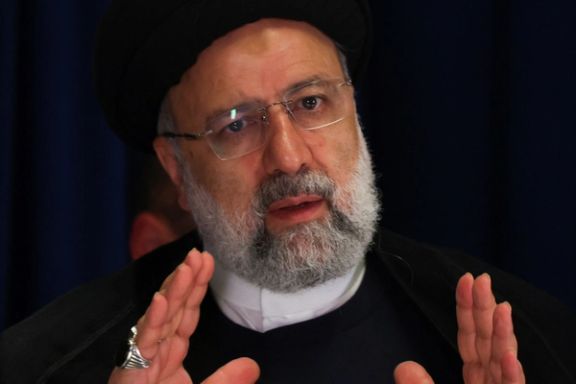
Activists, such as Ladan Boroumand, the co-founder of Abdorrahman Boroumand Center for Human Rights in Iran -- praised Iran International reporters for refusing to allow "the false narrative of the regime to become dominant”.
The composition of the entourage has raised serious questions as to how they were granted visas as part of its ‘diplomatic delegation'. Navid Mohebbi, a policy director with the National Union for Democracy in Iran think-tank, said, “These individuals should not have been granted entry in the first place" calling the entourage "thugs harassing journalists".
Recently-sanctioned Tasnim news agency, affiliated with the Revolutionary Guards, celebrated the circus created by the entourage behavior, publishing a video of one such case of harassment, boasting that “Iran International’s journalist fled in such a hurry that he didn't even turn back to pick up his headphones!”
Kasra Aarabi, with the United Against Nuclear Iran advocacy group, shared the video of the physical assault on Iran International’s Amini, saying, “This is what happens when you grant a mass murdering president and terrorist entourage entry to the West.”
One of the controversial figures who accompanied Raisi was a leader of a government vigilante mob who carried out the 2011 storming of the British embassy in Tehran. Now he is an advisor to the culture minister.
Moderate Iranian news website Rouydad 24, also criticized the selection of Raisi’s companions. Instead of ministers and high-ranking officials, Raisi’s team is comprised of “odd and peculiar people” who were tasked with “stopping foreign-based Persian-language media by shouting,” the media outlet said.
“If we look at President Raisi's agenda in New York, it appears more like a publicity campaign, and it probably won't yield any significant results,” Rouydad 24 said, pointing out that “What stands out most in President Raisi's trip to New York is the absence of an 'economic team' in his delegation, replaced instead by a group of 'slogan-shouting' individuals.”
Saman Arbabi, an Iranian-American journalist mainly known to Iranians as a co-creator and co-host of Voice of America's satirical television shows Parazit, released a video about his encounter with some of Raisi’s so-called ‘diplomatic delegation.’ He said when he saw how Raisi’s men attacked them when they sought to film them in an event at their New York hotel so “angrily and violently,” he tried to imagine the level of brutality during regime crackdown on protesters in Iran.

At least 600 women have been arrested in Tehran on the anniversary of Mahsa Amini's death on September 16.
Among this group, 130 individuals are presently being held in the quarantine wing of the notorious Gharchak (Qarchak) Prison south of Tehran, according to the Committee to Follow Up on the Status of Detainees.
Quoting the families of detainees, the committee said the majority of those arrested were released on bail upon their initial arrest by the police. Cases have been referred to the prosecutor's office, with hopes that they may secure their release on bail or bond.
The arrests took place across Iran. Javad Hashemi-Mehr, the political and security deputy of the governor of Kohgiluyeh and Boyer-Ahmad Province, reported that on the evening of September 16, 15 people, including 13 men and 2 women, were detained in Dehdasht alone.
In total, the committee has identified 118 detainees arrested between September 10 and 20. The regime's security forces, aiming to suppress the wave of protests that erupted last September following Mahsa Amini's death in police custody, intensified their pressure on activists and carried out numerous arrests, particularly in the days leading up to the anniversary of the protests.
The figures come as the wife of President Ebrahim Raisi, Jamileh Alamolhoda, gave a rare interview to US-based Newsweek claiming "women in Iran have not fought for their rights because they already enjoy their rights" while President Raisi himself claimed on the sidelines of the United Nations General Assembly this week that women in Iran have "unparalleled" rights. The two have been on a propaganda campaign during the visit to New York while the world watches.
The US-based Human Rights Activists News Agency (HRANA) has described the situation of women in Iran as “dire”.
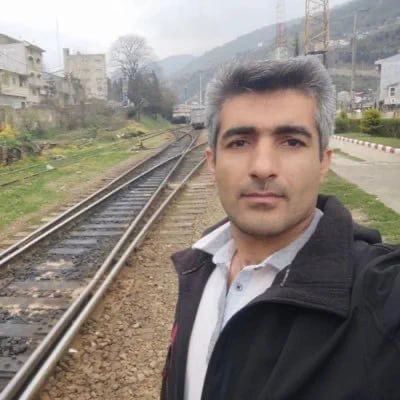
Families of the victims of the Iranian uprising continue to be detained by government agents as they attempt to grieve their loved ones.
On the anniversary of the death of Javad Heydari, who was killed last September by live ammunition, security forces arrested his brother and several other family members.
His sister, Fatemeh, reported that security forces also fired tear gas into their house as well as deploying troops to the village to quash any gatherings.
Heydari was killed in Qazvin on September 22 with live ammunition in a violent suppression of protests in the wake of Mahsa Amini's death in morality police custody. He was buried three days later in a nearby village.
Meanwhile, the ceremony to commemorate the death of Nika Shakarami, which had previously been announced by her sister, was canceled due to government pressure.
Nasrin Shakarami, Nika’s mother, wrote on her Instagram on Wednesday: "Due to the problems that have arisen, and of course, because I do not want any harm to come to the dear and honorable individuals who attend the ceremony, I am reluctantly canceling the ceremony."
Nika Shakarami took part in anti-regime protests last year and in images circulated from her, she can be seen setting fire to a headscarf and shouting slogans while standing on trash bins.
In her last call with her friend, she had said that security forces were looking for her on Keshavarz Boulevard in Tehran, and after that, she went missing.
Nika's body, which is said to have been subjected to torture, beatings, and sexual assault by security forces, was identified ten days later by her family.
After the news of the incident came out, government agents kidnapped her body and secretly buried it in a village in Lorestan.

Iranian-born actress and political activist Nazanin Boniadi has spoken out against President Ebrahim Raisi as he continues his propaganda mission at the United Nations.
She addressed the brutal suppression of protesters in the last year of unrest in the wake of the death in morality police custody of Mahsa Amini which has led to the deaths of hundreds in the hands of security forces. "You speak of human dignity, but you starve your own people… You speak of peace, but your security forces unleash brutality on citizens when they rise unarmed to demand justice."
Boniadi drew attention to the regional chaos the regime's militias are causing, in the Middle East and beyond: "You proudly proclaim your anti-imperialist views and condemn proxy wars and boots on the ground, while the Islamic Republic trains, finances, and arms militias throughout the Middle East, as well as supports Russia’s war against Ukraine."
Her rousing speech touched on the "mass graves" of protesters sent to the gallows, families unable to bury their loved ones, bulldozed by the regime to "pretend they never existed".
In contrast, during his address to the UN General Assembly, President Ebrahim Raisi shifted blame onto foreign nations, accusing them of conducting a propaganda campaign against the Islamic Republic. He made only indirect references to the 2022 anti-regime protests, describing them as the most extensive media onslaught in Western history.
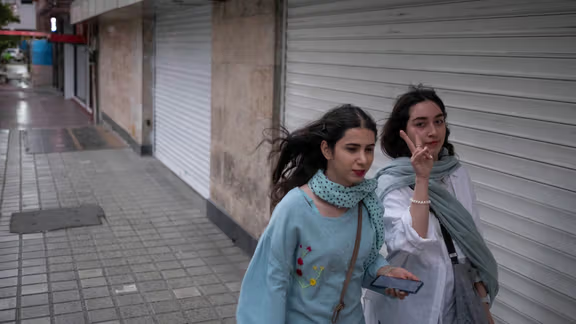
The protest movement in Iran in the past year did not topple the regime but succeeded in making a serious dent into one of its important tenets, the compulsory hijab.
“I will not put up a profile picture with mandatory hijab just to be allowed to join our WhatsApp work group,” this was the message Sara, an aspiring Iranian engineer working in Tehran, recently conveyed to her manager, disregarding the potential risk of dismissal.
Concerned for her safety and security, she asked her real name and the title of the Iranian startup company that employs her not to be disclosed. “I much rather have no profile picture than one with hijab,” read the next line of Sara’s message.
She was, moreover, sternly admonished to play by the book and refrain from posting any photos without hijab on her X account or to face possible dismissal from work.
"We Iranian women are not reverting to our pre-Mahsa era," she firmly asserted, alluding to Mahsa Amini, the 22-year-old Iranian woman whose tragic death on September 16, 2022, resulted from injuries sustained in police custody of Tehran’s hijab police. Her passing ignited a fresh wave of anti-regime protests throughout Iran and gave rise to the globally recognized "Woman, Life, Freedom" movement advocating for democracy in the Middle East.

The prosperous company where Sara is employed holds significant concerns regarding potential actions by regime authorities. Informed sources have revealed to Iran International that these authorities might conduct office inspections throughout Iran to ensure strict adherence to the mandatory hijab law among both management of private firms and their female employees.
Flabbergasted by the staunch defiance of women against the compulsory hijab law and on the first anniversary of Mahsa Amini’s death, the Iranian regime has been playing all its cards to deter women from taking off their hijab in public, but with very little success.
The streets were the scene of the most bizarre incident following Mahsa’s death: setting fire to headscarves as the symbol of more than four decades of enslaving women and holding hostage their most basic freedoms as to how to cover themselves and have control over their bodies.
This becomes particularly significant when considering that Iran is a Shia Muslim country where, following the 1979 “Islamic Revolution”, the clerical establishment mandated hijab and outlined the highest aspirations for an Iranian woman as being a “devout and revolutionary” mother and a “faithful and obedient” wife.
This time however, after decades of various campaigns, resistance, and enduring the harshest forms of suppression and imprisonment, women have courageously emerged in public spaces without headscarves. They are boldly proclaiming “Woman, Life, Freedom” a modern and forward-thinking slogan that has profoundly shaken the entire nation and indeed the world, drawing an overwhelming wave of empathy and support for the women's movement in Iran.
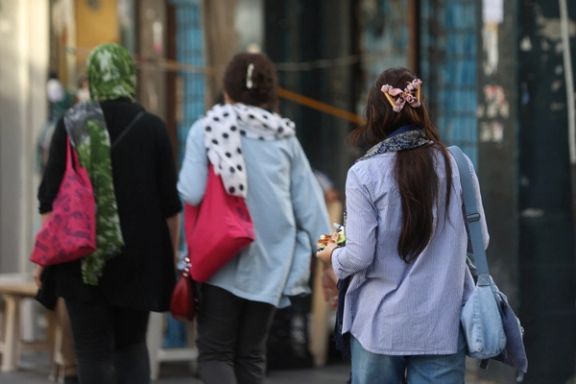
“I think Iranian women showed an unprecedented level of courage from the onset of the Women, Life, Freedom movement. They burned their headscarves, defying baton and bullets and said no to hijab despite being fearful of possible acid attacks, arrest, and sexual assault (by the regime agents),” said Sogand, a prominent Iranian women's rights activist, who asked not to be identified by her real name out of fear of retribution from the regime.
Elaborating more on her perspective regarding the direction that the Iranian women’s movement has taken after the death of Mahsa, she maintained that the bravery for removing and burning headscarves in public is not something that could either vanish or be stripped away from women easily. It is this enduring valor on the part of Iranian women that has instilled fear in the regime to the point that it constantly issues new orders and directives aimed at further tightening the enforcement of the compulsory hijab.
The top brass of Iran’s establishment has advocated for viciously severe punishment for women who opt to remove their hijab, including actions such as flagging, imposing heavy prison sentences as well as substantial financial penalties, and even depriving them from receiving medical care, banking services, or the opportunity to take part in the university entrance exam known as Concours.
Despite the ongoing intimidation campaign orchestrated by the clerical regime, many women's rights activists, including Sogand, firmly believe that it will ultimately fail to force women to retreat.
She emphasized that any additional acts of violence against women in connection with the mandatory hijab could further inflame public anger and potentially lead to a response similar to the widespread protests that erupted across Iran following Mahsa's tragic death.
The same belief is echoed by Zahra, a Tehran-based journalist who is identified by a pseudonym for protecting her safety. Recalling harrowing moments of terror after encountering a group of hardline plainclothes regime agents in southwest Tehran. They aggressively yelled at her and even threatened her physically for not covering her hair, and she clarified that other disobedient women likely share the same sense of terror and fear.
However, the unspoken and invisible bond they feel when passing by another unveiled woman with a smile on her face and a meaningful eye contact in silence is what motivates them to persist. The courage to resist the fear and intimidation that the regime seeks to instill in women's hearts is what truly makes them the everyday heroines they are, according to Zahra's perspective.
Two Iranian lawyers talking to Iran International on condition of anonymity, highlighted the case of one of their clients in Tehran who, as a government employee, refused to comply with the mandatory hijab law. Even after being charged and suspended from work several months ago, she stood her ground, asserting that she would not appear in court wearing hijab.
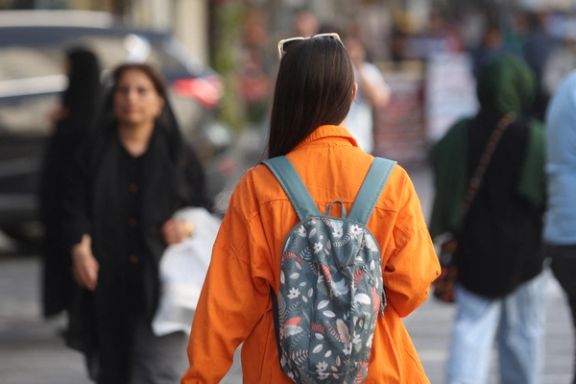
Discussing another female client whose small restaurant has been sealed twice in the past year due to her refusal to adhere to the hijab law, one of the attorneys remarked: “As a single mother, my client is currently facing significant financial hardship. However, whenever she visits my office, she arrives without a veil and firmly declares that she will not back down.”
In the year following Mahsa’s tragic death, Iranian society has also witnessed huge cracks in the thick and tall walls of the patriarchal system, which is deeply ingrained in the minds and collective consciousness of Iranians. This system has received persistent and substantial backing from the misogynistic and sexist regime. However, Iranian men have begun to publicly voice support for women’s human rights and freedoms by joining hands with them in rejecting mandatory hijab, which has turned women’s free will into a battlefield for the Iranian regime as it attempts to export its hardline ideologies.
Numerous women’s activists including Mahya Ostovar, an Iranian lecturer at the University of Galway in Ireland, firmly believe that the Woman, Life, Freedom movement has succeeded in bringing about a revolution, most of all in the minds and viewpoints of the rest of the society. It has motivated many to stand for women's cause and to advocate for a democratic Iran, free from the grip of a brutal clerical regime.
One year into the birth of this new movement, Iranian women have displayed remarkable resilience and determination. Collectively, they have boldly confronted the Iranian regime, showing no signs of backing down.
Considering this unwavering determination, Ostovar conveyed her belief that the Woman, Life, Freedom movement signifies the culmination of decades of women's activism and their fight for their rights. Consequently, it is not anticipated to regress, but rather continue and ultimately contribute to the downfall of the Iranian regime.
(This is an article by Maryam Moqaddam and Masoud Kazemi, journalists at Iran International)






